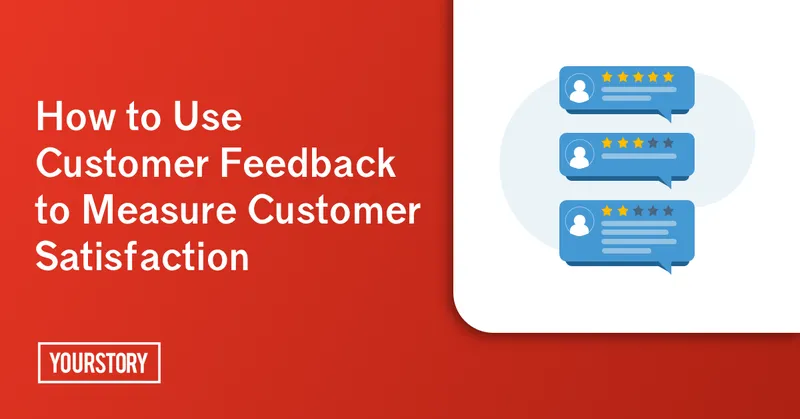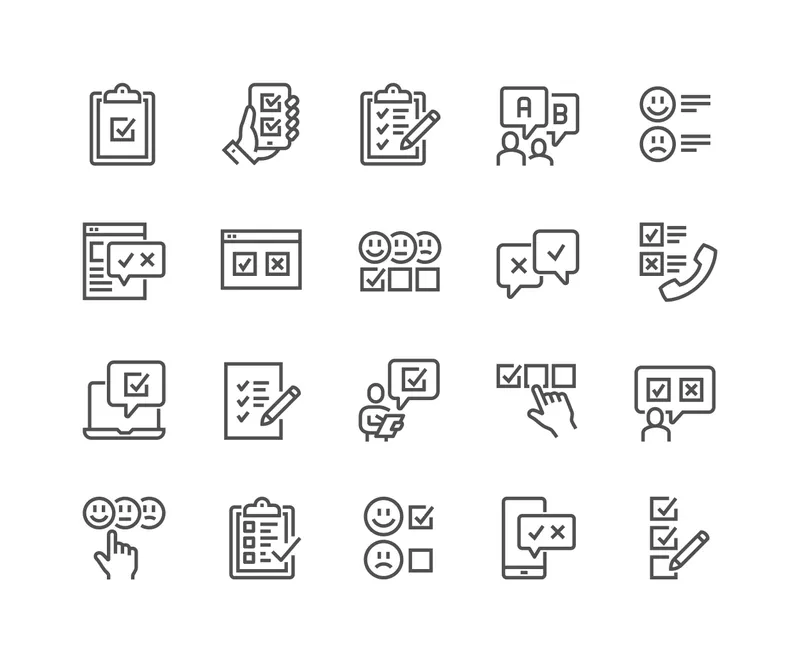How startups can effectively measure customer satisfaction through feedback
Customer feedback has a lasting, wide-ranging impact on improving organisational performance. The good thing for online businesses of today is that there are a number of customer feedback tools that are tested and available for use.
No business will look down on the importance of customer satisfaction. At least, no business wants to keep its customers and gain new ones.
Customer is king has been long acknowledged in the business world. All businesses bow to the chance they get to serve their target customer. Fore and aft, they spend time analysing their ideal buyer persona. Armed with this understanding, they try to get the best products out of their stables.

Fulfilling the customers’ needs and getting a chance to serve them again is the ultimate pat on the back for a business.
When the importance of customer satisfaction is understood by businesses, they add those tiny touches that make a product/service irresistible. To satisfy the need for doing laundry, there are a dozen detergent manufacturers.
But the manufacturer who has come up with a cup-measure for the detergent? That seller has gone the extra mile in thinking of the needs of the household. A bottle cap that doubles up as cup-measure? That one is thinking of both utility and convenience.
A business relationship is seen by many as a commercial transaction. This couldn’t be further from the truth. At the core of every business, the transaction is an exchange of value. To see if the customer’s idea of value is met, feedback is the gateway.
To optimise this value, sharpen customer focus with the help of client feedback. The good thing for online businesses of today is that customer feedback tools are tested and available for use.
It is more than just a feedback

Feedback makes way for the importance of customer satisfaction to be realised. You could do business with blinders on, but the first whiff of feedback will instantly put you on the straight and narrow. Nothing teaches like experience, and a customer feedback questionnaire is full of it. It gives a window into how the buyer-side things went.
The importance of customer satisfaction is well-established by brick-and-mortar business houses as well as ecommerce businesses that only have a virtual connection with their customers. If anything, the importance of customer satisfaction is even more in the latter case. This is because the retention of customers in this latter case is that much dicier.
Regardless of where your business operates, the importance of customer satisfaction is always front and centre.
Some key points that are affected by customer feedback survey:

Customer retention: When customers feel heard, they want to give the brand a second chance. The promise of incorporating feedback and bringing out a better version keeps them trusting your brand. They repose faith in your model and help you build a better product. This way, the feedback you garner becomes the building block of your development.
Team morale: Everyone on the team of making up a good product and delivering it into the hands of the customer has this one shared motive. They work with single-minded focus. Any and all feedback coming in will help them fine-tune their product. When there is a clear channel of user feedback that developers can use, they would be more enthused than ever to do their job well.
Word-of-mouth referral sales: It’s the magic spell behind swelling sales numbers, with reasons that are grounded in reality. Word-of-mouth publicity is the most believable. Your satisfied customers are your biggest advocates.
Brand image: The way your business is perceived by market forces is completely reliant on the buzz created by the customers that walk in and out of your store. You’re looking for footfalls and purchasers. This is why it is important for you to treat all visitors (non-buyers included) courteously.
Numbers: It’s not just your sales figures that are set to jump when you use feedback judiciously. Your bottom line will thank all the customers who have provided tangible suggestions. You will notice increased business and lead generation, and falling attrition. There will be fewer people wanting to leave the brand, and more people will want to be associated with it, at least on a contractual basis.
Ask and it shall be given – applies to customer feedback too

The trouble with sellers is that they want buyers to buy, and once that transaction is in the bag, they don’t want to interfere with the customer’s time anymore. Little do they realise that taking feedback from customers can happen in several different ways. Not all of them have to be in-your-face, getting in the customer’s way and making them feel put upon.
When communicating with your buyer through e-mail, it’s easy to slip in a customer feedback form sample into the email which they can answer right there. Their answers will be logged and reported to you instantly. A hardcopy of the customer feedback questionnaire can be mailed out by snail mail too.
But considering how few people keep up the use of snail mail, this is a less-effective mode of gathering customer feedback. Instead, send them a QR code they can scan so that a customer feedback survey will pop up on their phones or tablets. From this point, getting the answers is almost a no-brainer!
Customer feedback form format – simple and straight-forward does the trick

Take any customer feedback form and there are parts that you recognise immediately
The questions get the paramount position on the feedback form. Whatever the customer feedback form format, there will be questions.
They might be multiple choice questions for the most part. There would be a chance to fill out the answer in one’s own words if none of the answer choices meets the exact wording the customer is looking for.
Then, there is the part that asks for the customer’s contact information. You can take this opportunity to ask the customer some more of his/her personal information such as a birthday or an anniversary.
You could use this date to reach out with a special offer as part of a greeting. This is a thoughtful way of reaching out and reminding the customer of your association and making way for more opportunities to do business.
Then there is the final question, framed creatively as “If there were one thing you would like to change about our offerings, what is that?”
Such questions help you find the overall perception the customer has of your company and your products.
No answer is wrong – even the most outré answer gives you a picture into the psyche of your customer. This is precious understanding of the customer that you cannot risk not having.
Customer feedback questions – be customer-friendly like everything else

Short and sweet: These questions should not be long and descriptive. Such questions will not even merit a glance from the hurrying user. Anything longer than a line will lead to skimming or not being read at all.
The number of questions: Likewise, the number of customer feedback questions should be limited – as many as can fit on a page. No user would be ready to flip through and answer pages and pages of questions. Six to seven questions should be a good bet.
Enable easy answering: Offering multiple choices will make the answering process really easy for the customer. Again, the answer choices should be crisp and to-the-point.
Quality of questions: Have only one open-ended question, if you must. All the rest should come under the purview of one-word answers or easily-clickable answer choices.
Don’t limit answers: A word limit on the open-ended question’s answer field will limit whatever a customer wants to say. Leave at least one field without limits so that customers can fill it out with their exact feedback.
Be grateful and positive: In all your communication through this page, express gratitude for the customer’s share of business brought in, and for the time they take out to offer feedback.
Be brief: There is no need to offer elaborate reassurances. The purpose of the customer feedback questionnaire is to collect information, which it must do efficiently. Other than an introductory line telling readers what the form is about and signing off, no other communication needs to be attempted.
Meet the brief and send out the simple, straight-forward customer feedback form to all your buyers with plenty of time to fill it. A simple report collating all the answers will give you a snapshot of how the product/service met with their favour.
You ultimately establish the importance of customer satisfaction within the first few times of sending out the questionnaire.
A related matter: Taking several rounds of feedback is recommended. But don’t, for even once, think it is okay to send out the same questionnaire out as a repeat. Customers will see the lack of effort on your part, and it will spell carelessness.
Worse, it will look like you have nothing new to ask. And when freshness is lacking, customers will not take the trouble to come out and answer.
A customer feedback system – a necessary organisational function

Looking at all these specifications about how questions should be, and how customer feedback forms should be, it is rather clear that the process of gathering customer feedback is not to be done lightly.
In fact, having a good customer feedback system in place is for the good of the entire business.
A whole organisational chain of command should be involved in creating feedback forms, getting feedback from customers, collating, reporting, and inferring from it, and finally in implementing the feedback.
If the change is for all to see, even those customers who may have switched brands will consider making their way back.
A customer feedback system is a piece of software functions, commands, user interfaces and dashboards that makes it easy to observe the life cycle of feedback. Sending out feedback forms and inquiries is made seamless.
Drafting questions, generating common responses (for answer choices) and customer data are readily available as functions, making the user adept at drawing appropriate feedback to answer specific questions, say, about a newly launched product or event that is about to go live. Such feedback drives also create interest in an event and help the right target audiences to take notice of it.
Advantages of using a customer feedback system

It’s efficient: Many templates for asking questions and getting follow-up answers or reviews are in place. You just have to deploy them to the right set of customers. All this can happen at the hit of a button. A single event like the end of a promotional event or a sale can be used to start this feedback campaign.
It’s comprehensive: The system (Qmatic, for instance) remembers every little detail that you are supposed to go over. Want to ask your customers how they liked your logo or ambience, include that in your questions.
It’s real-time: Gathering customer feedback should be facilitated through a variety of modes. This includes one-on-one interviews, group discussions, Usability Testing, and much more.
It’s easy to use: Use a web-based or device-based app or a software package that brings all your needs under one umbrella. This means the efforts to gather and use feedback are uniform and standardised whether they are used by the employees on the shop-floor or by managers or higher-ups across a different domain – say, online.
It integrates social media engagement: Choosing a smart customer feedback system can help you keep track of just ‘likes’ and ‘followers’. It can also help you see the kind of posts you’re getting tagged in, whether you are being recommended or dragged down by those who have used your services in the past.
It boosts insights: Where customer feedback survey tools only give you the figures, the more comprehensive customer feedback system uses analytics and data science concepts to help you make intelligent observations across time and for special events like product launches.
Use imaginative customer feedback
For instance, it is very well to ask them to check a graded response from ‘very dissatisfied, mildly dissatisfied, satisfied, delighted’.
But instead, use a scale of responses that move freely between five (or even 10) ranges of satisfaction.
Users just move the cursor to the appropriate level to record a response. Graphics and provisions like these make way for interesting question formats.

Ask ‘how likely are you to recommend ABC services to a friend’ or ‘on a scale of 1-10, how would you rate the services you just experienced?’ A basic customer feedback form template will also contain a field for contact information that you can make compulsory or optional.
Getting contact information this way makes it easy for contact in the future when you wish to promote new products, short-term promotions or exclusive offers for one set of customers – say those who have provided you useful guidelines.
Taking the best from customer feedback examples
The next, all-important question that you address is what you do with all the feedback that you gather.
Often, feedback can be hard to digest as it might seem unfair or completely unfounded.
There is even the possibility that the customer’s perception is skewed against your product. Wisdom lies in taking into consideration all that has been said, and changing what you can.
Sometimes, competitors’ products might come off better in comparison. Or the customer might blame your product/service when it isn’t really your fault.
Make notes of things that you can change, and strive to serve your customer better despite the unfair evaluation you might receive once. This is the only way to change their ideas.
The many forms and importance of customer feedback
Customer feedback examples as simple as a comment on a newly-launched app can be very insightful into how well it is performing its target set of functions.
Types of customer feedback include comments, reviews, social media ratings and notes, even personalised messages and status messages. Businesses and individuals can be tagged as part of customer feedback.
Once in a while, you would have the customer who is extremely tough to please. He or she would find fault with everything and would give you a solid zero for your best efforts. At times like these, it is important to remember the advantages of negative feedback.
The negative rating pulls us up and makes us take a good hard look at our approach and way of doing things. We might even be forced to study the way a competitor does things and learn from what is good there. A wholly new approach might be found, and this shake-up is a good thing.
Customer feedback form questions – A guideline to getting useful feedback
When it comes to soliciting feedback, do not be afraid to guide the customer on how to give feedback.
For instance, Zomato gives users a brief idea of how to write a good review.

It asks the user to mention where the restaurant is, how easy it is to spot, comment on the menu and knowledgeability of the wait staff, etc. These are guidelines that the user can expand on while writing the reviews.
Once these basics are in place, there is really no limit to the way the user can express their ideas and narrate their experiences. These are useful records to have both for the business owner as well as the general public, as they tell future users what to expect of a business.
Customer feedback has a lasting, wide-ranging impact on improving organisational performance. Feedback forms and questionnaires are highly-customisable. Use them wisely to make the most of the hours spent on design and production.









